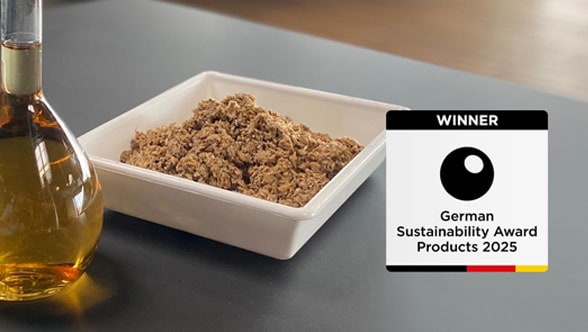Plant for biomass conversion
Like a phoenix from the ashes ...
Brewery residuals are by no means “waste” –they can be used for energy and fermented to create biogas, which is then converted into thermal and electrical energy in a combined heat and power plant. Breweries are therefore capable of providing their own energy supply in a self-sufficient and CO2-neutral manner if they choose to produce on the principle of the Steinecker Brewnomic.
However, the solely energy-based utilisation of biological residual materials is no longer undisputed, as they are also nutrient-rich and therefore high in value, for the food industry for example. Steinecker now wants to solve this problem with the Phoenix BMC* development project, a plant for biomass conversion: the residual materials are first converted into valuable raw materials, before the other remaining waste materials are used for energy.
New since November 2023
The first module for recovering protein hydrolysate from brewing residues has now been successfully included in the pilot project.
At a glance
- Separation of protein hydrolyzate and mineral fertilizer from the brewery residuals before they are used for biogas
- As a result: use of a considerably smaller biogas plant possible thanks to the improved utilisation of the biomass
- Steinecker Brewnomic module: basis for an energy self-sufficient and CO2-neutral brewery
* BMC: Biomass Conversion
Energy recovery using brewery residuals
The initial problem
With conventional biogas plants, there are limits to the degree to which the solid brewery residuals, such as spent grains, malt dust and yeast, can be processed. In addition to the already poor usability of the residual materials, they also contain substances that have an inhibiting effect on the activity of the various microorganisms in a biogas plant.
The solution: Phoenix BMC
- Once these inhibitors are first removed from the brewery residuals, considerably less time is needed to use the residual materials with organisms effectively.
- The biogas plant can therefore be built considerably smaller and also cheaper.
Proteins – both an inhibitor and a precious commodity
Protein as an inhibitor
- In the biogas plant, the existing proteins are broken down by one of the many strains of bacteria, and the amino groups of the amino acids released as ammonium.
- Depending on the pH value, the ammonium is in a chemical equilibrium with the ammoniac, which inhibits the activity of a further strain of bacteria.
- This breaks down fatty acids which, if the concentration is too high, deactivate the methane-creating bacteria in the biogas plant.
- The breaking down of the proteins in the biogas system starts inhibiting methane production. The protein and already released ammonium must therefore be separated from the residual materials before biogas fermentation can begin.

Protein as a precious commodity
- Plant-based protein is however also a very sought-after raw material, which is primarily used in the manufacture of meat and milk-substitute products.
- Also ammonium, which is obtained in the form of mineral fertilizer and urgently required in the farming industry, can be lucratively sold by the brewery.
The sale of proteins and mineral fertilizer therefore contributes considerably to the amortisation of the biomass conversion.

The line concept in detail
Module 1
- Mash tun kettles for dispersion and hydrolysis of the solid brewery residuals
- Membrane filter for the separation of protein hydrolyzate
Module 2
- Fermenter for the acidification process
- Membrane filter to separate the remaining solids
- Ion exchanger and mixing tank to obtain mineral fertilizer
Module 3
- Biogas plant for obtaining methane

Module 1 based on the design of the Steinecker CombiCube
Benefits to you
New raw materials as a source of income
Protein hydrolyzateand mineral fertilizer can be acquired from the brewery residuals. Selling them on provides a major contribution to the amortisation of the plant for biomass conversion. Both this and the better recyclability of the residual materials in the biogas system make an investment in your own self-sufficient energy supply lucrative.
Energy-independent, CO2-neutral brewery.
The increasing percentage of biogas reduces the need for fossil fuels. Using the corresponding modules from the Brewnomic concept will make it possible to cover a brewery’s entire energy requirement. And since the residual materials are of a biological origin, the brewery is also CO2-neutral.



